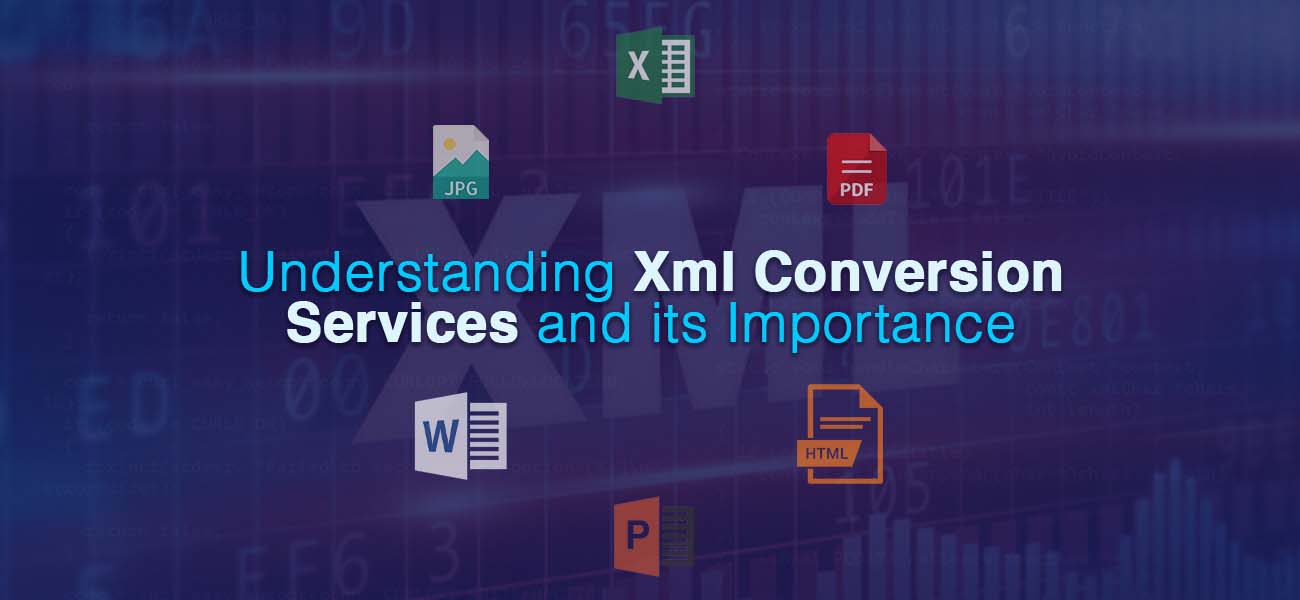Everything You Should Know About XML Conversion
We need to recognize that data comes in various forms, and managing it can be challenging. Dealing with messy formats and interpreting unstructured data can be tough. This is where structured transformation becomes important. XML conversion serves as a bridge, bringing order from chaos and providing consistency and clarity across systems.
Whether you work in publishing, financial technology, or healthcare, this process promotes smooth communication and improves workflows. Are you looking to make your data efficient, usable, and scalable? You are in the right place. This blog will take you through the process in detail.

What is XML Conversion?
It is the process of transforming data from various formats into XML (Extensible Markup Language) or vice versa. XML is widely used because of its flexibility in representing structured information.
Converting data into XML allows it to be easily shared, stored, and interpreted by different systems. The reverse process—converting XML into other formats—makes the data consumable for specific applications or reports.
Why is XML Conversion Necessary?
-
Interoperability
One key reason for XML data conversion is interoperability. When different software systems need to communicate, data compatibility becomes essential. XML serves as a universal data exchange format, allowing applications written in different languages or platforms to interact seamlessly.
-
Data Migration
Organizations often move data from legacy systems to modern platforms. During this migration, structured data needs to be extracted, transformed, and loaded correctly. Here, XML data offers a versatile and standardized way to handle this transition.
-
Simplification for Analysis
Data locked in obscure or inconsistent formats is hard to analyze. Converting it into XML simplifies hierarchical structuring, making it much easier to perform statistical or business analysis on clean, categorized datasets.
-
Data Presentation
Visualizing data matters. With XML, information can be easily styled using technologies like XSLT or transformed into HTML. This structured formatting supports consistent data presentation across multiple platforms and devices.
-
Application Compatibility
Different software applications require data in specific formats. Through XML conversion tools, you can adapt your existing datasets to ensure they are compatible with a wide variety of programs, thus increasing usability.
Types of XML Conversion
-
XML to JSON Conversion
This is commonly used for web-based applications and APIs. JSON is lightweight, and converting XML into JSON enables faster data processing for dynamic platforms.
-
XML to CSV/Excel Conversion
Ideal for tabular data analysis, this conversion helps users view and manipulate structured XML data within spreadsheets. It’s particularly useful in business intelligence and financial reporting.
-
XML to HTML Conversion
Turning XML into HTML enables the data to be rendered on web browsers. This is particularly useful for content-rich websites, where the backend maintains structured XML, but the frontend requires user-friendly HTML.
-
XML to SQL Database Format
This conversion is crucial for storing structured XML into relational databases. It enables efficient querying and robust data management.
-
XML to YAML Conversion
YAML is often used in DevOps and configuration files due to its readability. Converting XML into YAML supports easier manual editing and integration into automation tools.
How XML Conversion Works?
-
Manual Conversion
This involves opening the data files and manually editing the structure or syntax. While feasible for small datasets, it is highly time-consuming and prone to errors.
-
Using XSLT (Extensible Stylesheet Language Transformations)
XSLT enables rule-based transformation of XML documents. You define templates and transformation logic, and the engine handles the rest. It’s powerful but requires technical know-how.
-
Automated Conversion Tools
These simplify and expedite the process of converting data into or from XML:
- Online Converters: Quick and user-friendly, these tools support basic conversion for small files. However, they may not handle complex structures or ensure privacy.
- Programming Libraries: Languages like Python, Java, and JavaScript offer robust libraries for XML handling. These libraries are perfect for developers who need custom workflows and high scalability.
- Enterprise Solutions: High-end XML conversion service platforms offer secure, scalable, and integrated solutions for large datasets. These are ideal for enterprises with strict data governance needs.
- Custom Scripts: For tailored solutions, scripts can be developed to perform recurring conversions. They offer complete control and automation when standard tools fall short.
Benefits of XML Conversion
-
Increased Efficiency
By converting data into XML or vice versa, organizations can automate repetitive tasks, reduce manual intervention, and streamline workflows. This leads to faster project delivery and reduced labor costs.
-
Improved Data Access
Structured XML data is easier to navigate and search. Whether through XPath, DOM, or other methods, accessing specific elements or values becomes quick and efficient. This enhances data utilization across departments.
-
Data Interoperability
Thanks to its platform-independent nature, XML enables seamless data exchange between systems, vendors, and formats. This is crucial in sectors like healthcare and finance, where systems must "talk" to each other despite differences.
-
Better Analysis and Reporting
With structured and tagged information, XML data becomes highly analyzable. Tools like Excel, BI dashboards, or custom analytics engines can process the data more effectively, providing deeper business insights.
-
Scalability
Whether you are dealing with a few megabytes or terabytes of information, XML handles it gracefully. Its hierarchical nature makes it adaptable for growing datasets without a complete overhaul of your systems.
Challenges of XML Conversion
-
Data Loss
Improper conversion can result in missing elements, broken hierarchies, or lost metadata. Ensuring mapping accuracy between formats is critical to preserving data fidelity.
-
Data Integrity
Maintaining the original semantics and structure of the data during conversion can be tough. Minor discrepancies can lead to incorrect processing or misinterpretation.
-
Handling Complex Structures
Nested or heavily tagged XML files can pose challenges during conversion. Flattening or translating such hierarchies into simpler formats like CSV may require custom logic.
-
Performance Issues
Large XML files can slow down processing, especially with manual or poorly optimized tools. Efficient parsing and multi-threaded processing become necessary in such scenarios.
How to Choose the Right XML Conversion Service?
-
Ease of Use
The service should offer an intuitive interface, clear documentation, and minimal technical barriers, making it accessible to users with varying levels of expertise.
-
Scalability
Look for a solution that can handle both current and future data loads. Whether it's a few hundred records or millions, the system should scale effortlessly.
-
Accuracy and Data Integrity
Precision in conversion is non-negotiable. A good XML conversion service ensures that the output maintains the structure and meaning of the original data without any corruption.
-
Cost-Effectiveness
Balancing price and performance is essential. Free tools may lack features, while enterprise-level platforms could be overkill for small tasks. Evaluate based on your volume and frequency of conversion.
Conclusion
XML conversion is more than just a technical process—it’s a strategic enabler for smarter, faster, and more reliable data use. Whether you're simplifying data analysis, achieving interoperability, or preparing your datasets for different platforms, understanding this process pays dividends.
From manual methods to automated tools and enterprise services, you have plenty of options tailored to your needs. The right strategy not only preserves your data’s integrity but also transforms how your organization leverages information. Choose wisely, stay efficient, and let your data work smarter—not harder.



